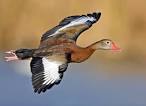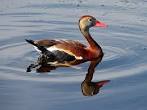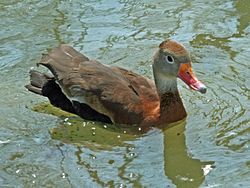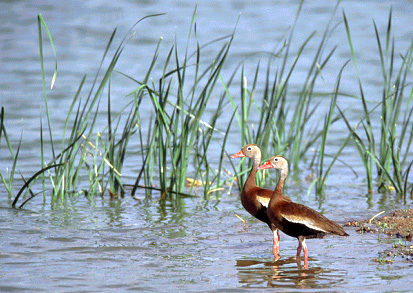The black-bellied whistling duck, formerly also called black-bellied tree duck, is a whistling duck that breeds
from the southernmost United States and tropical Central to south-central South America. In the USA, it can be
found year-round in parts of southeast Texas, and seasonally in southeast Arizona, and Louisiana's Gulf Coast.
It is a rare breeder in such disparate locations as Florida, Arkansas, Georgia, Tennessee, and South Carolina.
There is a large population of several hundred that winter each year in Audubon Park in uptown New Orleans,
Louisiana. Since it is one of only two whistling-duck species native to North America, it is occasionally just
known as the "whistling duck" in the southern USA.
Description
The black-bellied whistling duck is a mid-sized waterfowl species. Length ranges from 47 to 56 cm (19 to 22 in),
body mass from 652 to 1,020 g (1.437 to 2.249 lb) and wingspan ranges from 76 to 94 cm (30 to 37 in). It has a
long red bill, long head and longish legs, pale grey head and mostly grey-brown plumage. The belly and tail are
black, and the body plumage, back of the neck and cap are a rich chestnut brown. The face and upper neck are
grey, and they sport a thin but distinct white eye-ring. The extensive white in the wings is obvious in flight,
less so on the ground; it is formed by the secondary remiges while the primaries are black; the wing-coverts are
brown. Males and females look alike; juveniles are similar but have a grey bill and less contrasting belly.
The wing bar is unique among living whistling ducks. When on the ground, it may be hard to discern the light
flanks present in many of these waterfowl. The fulvous whistling duck (D. bicolor) is the only sympatric
whistling duck that shows such a whitish flank stripe, and it differs from the black-bellied by having dark
wings and a lighter belly rather than the other way around. Juvenile D. autumnalis are quite similar to young
of the white-faced whistling duck (D. viduata), which have a darker bill and no white wing patch; even when
sitting they never seem to show white along the sides, as their thin white vertical barring on the black flanks
is very indistinct.
As the name implies, these are noisy birds with a clear whistling waa-chooo call.
Ecology
The black-bellied whistling duck is a common species that is "quite tame, even in the wild". It is highly
gregarious, forming large flocks when not breeding, and is largely resident apart from local movements. It
usually nests in hollow trees. The habitat is quiet shallow freshwater ponds, lakes, and marshes, cultivated
land or reservoirs with plentiful vegetation, where this duck feeds mainly at night on seeds and other plant
food.
Movements
The black-bellied whistling duck is mainly non-migratory. Birds in the extreme northern portions of their
range (Arizona, Louisiana, and parts of Texas) move south in winter. At the heart of their range, there is a
tendency to travel in flocks over the winter months, though this behavior is not a true long-range migration
but rather local dispersal. 7 adults and 8 ducklings were observed on west side of Lake Apopka, Central
Florida, 7-24-15. They have been in this area for more than a year. There has been a large flock noted for
about two years in the River Plantation area of Parrish in Manatee County, Florida. A large flock was
observed and photographed by a local resident in Audubon Park, New Orleans, Louisiana in February 2016. Over
100 of the whistling ducks have resided in the Gum Slough of Sumter County, Florida for over 2 years.
Reproduction
The black-bellied whistling duck is quite unique among ducks in their strong monogamous pair-bond. Its pairs
often stay together for many years, a trait more often associated with geese and swans. Both parents share
all tasks associated with the raising of young, from incubation to the rearing of ducklings. The ducks,
primarily cavity nesters, prefer the confines of a hollow tree, but will nest on the ground when necessary.
They also make use of chimneys, abandoned buildings, or nest boxes, the latter having been increasingly
provided to them over recent decades, especially in southeast Texas and Mexico. Ducklings leap from nest
cavities within two days of hatching, can feed themselves immediately, and stay with the parents for up to
eight weeks.








